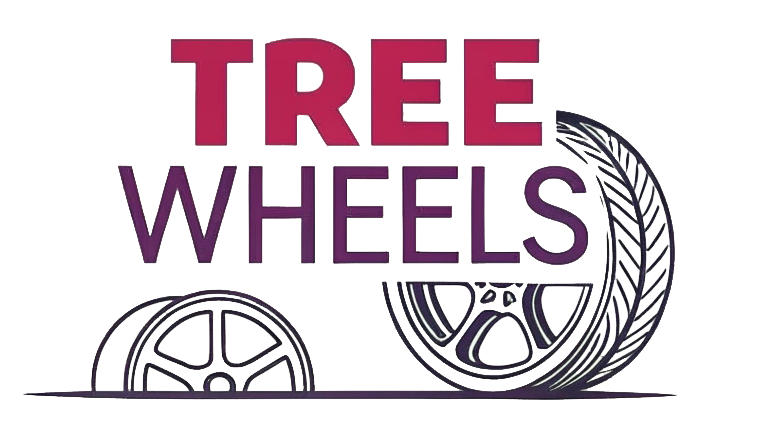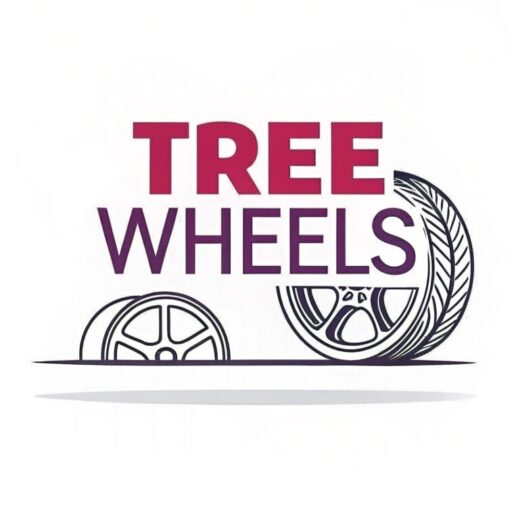I've seen countless car enthusiasts stare at their factory 17-inch wheels with dissatisfaction. You want something with more visual impact, but worry about potential damage to your vehicle or safety issues.
Yes, you can replace 17-inch wheels with 18-inch wheels if you maintain the overall tire diameter. This requires selecting lower-profile tires for the 18-inch wheels so the combined wheel and tire height remains within 3% of original specifications, preserving speedometer accuracy and vehicle handling.
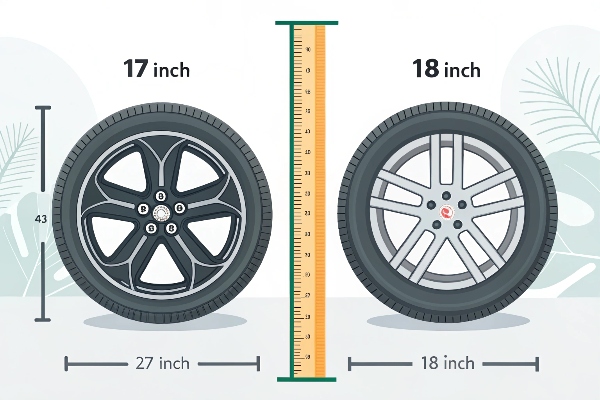
When upgrading wheel size, proper research prevents expensive mistakes. I've helped numerous customers navigate this modification successfully, and I'll walk you through everything you need to consider before making the switch.
Is It Okay to Change Rim Size?
Many car owners feel frustrated by their vehicle's stock appearance or handling. You may wonder if changing your rim size is a safe modification or if it risks damaging your car or voiding warranties.
Yes, changing rim size is acceptable when staying within manufacturer guidelines, typically within ±1 inch of original equipment. Proper tire sizing must complement the new wheels to maintain overall diameter and load capacity, ensuring safe handling characteristics.

Changing rim size requires careful consideration of several factors beyond just diameter. When I first started in the wheel industry, I quickly learned that proper fitment involves multiple dimensions. The key is maintaining what we call "plus-sizing" compatibility.
When increasing rim diameter, you must decrease tire sidewall height proportionally. For example, going from a 17-inch to 18-inch wheel requires reducing the tire's aspect ratio (sidewall height percentage) to maintain a similar overall diameter. This is critical because significant changes to your rolling diameter affect speedometer readings, transmission shifting points, and even ABS/traction control system operation.
Additionally, you must consider wheel width, offset (how the wheel sits relative to the suspension), and bolt pattern. Different vehicles have different tolerances for these changes. Performance-oriented vehicles often have more flexibility for upgrades than economy cars.
Plus-Sizing Chart Example:
| Original Size | Upgraded Size | Tire Aspect Ratio Change | Overall Diameter Difference |
|---|---|---|---|
| 205/65R17 | 225/55R18 | -10% (65% to 55%) | +0.2% (acceptable) |
| 225/60R17 | 245/50R18 | -10% (60% to 50%) | +0.3% (acceptable) |
| 235/55R17 | 245/45R18 | -10% (55% to 45%) | -0.8% (acceptable) |
Will Bigger Rims Damage My Car?
You've probably heard horror stories of expensive damage from wheel upgrades. The fear of damaged suspension components, increased wear, or compromised safety might be holding you back.
Properly sized bigger rims won't inherently damage your car. However, incorrect fitment (improper offset, excessive weight, or incompatible width) can stress suspension components and bearings. Low-profile tires offer less cushioning, potentially increasing impact damage risk.
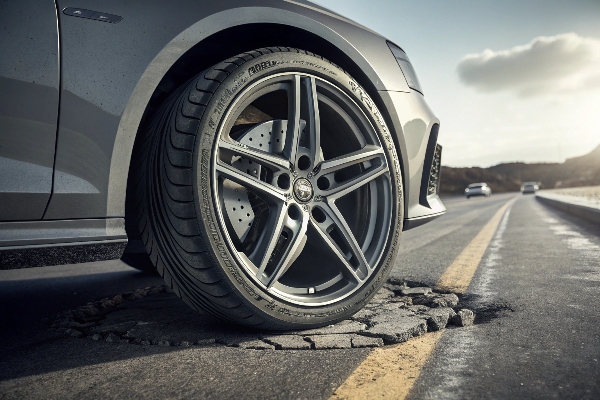
The relationship between wheel size and vehicle durability goes beyond simple diameter measurements. I've seen many customers focus solely on appearance without understanding the mechanical implications of their wheel choice.
Weight is a critical factor often overlooked in wheel upgrades. Heavier wheels increase unsprung weight—the mass not supported by your suspension. This affects both ride quality and handling. Each pound of unsprung weight has a multiplied effect on suspension performance. High-quality forged wheels like those from Tree Wheels actually reduce weight compared to factory wheels, potentially improving performance.
Offset (measured in millimeters) determines where the mounting surface sits relative to the wheel's centerline. Too much deviation from factory specifications can place additional stress on wheel bearings and suspension components. I generally recommend staying within ±5mm of the original offset unless making comprehensive suspension modifications.
The reduced sidewall height accompanying larger wheels offers less cushioning against impacts. A 17-inch wheel with a 55-profile tire has substantially more rubber to absorb pothole impacts than an 18-inch wheel with a 45-profile tire. In areas with poor road conditions, this consideration becomes particularly important.
Impact of Wheel Changes on Vehicle Components:
| Component | Effect of Improper Sizing | Maintenance Recommendation |
|---|---|---|
| Wheel bearings | Accelerated wear from incorrect offset | Regular inspection after upgrade |
| Suspension arms | Stress from altered geometry | Check bushings and ball joints |
| Brake components | Potential clearance issues | Verify caliper/rotor clearance |
| Fenders/body | Rubbing during compression | Test full articulation before finalizing |
How Much Difference in Tire Size Is Acceptable?
When shopping for new wheel and tire combinations, the various size options can be overwhelming. You need to know exactly how much deviation from stock is safe for your vehicle.
A tire diameter variance of ±3% from original specifications is generally considered safe. Greater differences can affect speedometer accuracy, transmission behavior, and electronic stability systems. Use tire size calculators to compare dimensions before purchase.
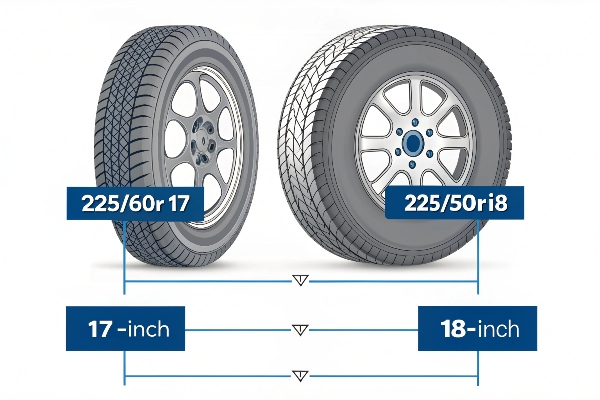
Understanding tire sizing codes is essential when upgrading wheels. I always emphasize to my customers that the three key numbers in a tire size (like 225/45R17) each play a critical role in determining compatibility. The first number (width in millimeters), the second (aspect ratio/profile as a percentage), and the last (rim diameter in inches) combine to determine the overall diameter.
When increasing wheel size by one inch, you typically need to decrease the tire's aspect ratio by 10-15 percentage points to maintain a similar overall diameter. For instance, if your car came with 225/60R17 tires, appropriate 18-inch options might include 225/50R18 or 235/45R18.
Modern vehicles with advanced electronic systems are particularly sensitive to tire diameter changes. Traction control, ABS, and stability control systems all rely on accurate wheel speed data. Significant size differences can compromise these safety features and trigger warning lights.
Different vehicles have different tolerances for size deviations. Sports cars and performance vehicles generally have less clearance and tighter specifications than SUVs or trucks. In my experience working with high-performance vehicles, I've found that German and Japanese performance cars often have the strictest requirements for maintaining proper fitment.
Tire Size Comparison Calculations:
| Original Size | New Size | Overall Diameter Change | Speedometer Error | Recommendation |
|---|---|---|---|---|
| 225/60R17 | 225/50R18 | +0.3% (27.3" vs 27.4") | Negligible | Acceptable |
| 225/60R17 | 245/45R18 | -1.8% (27.3" vs 26.8") | ~1.8% faster | Acceptable |
| 225/60R17 | 265/40R18 | -3.3% (27.3" vs 26.4") | ~3.3% faster | Borderline |
Does Changing Rim Size Affect Alignment?
Many car enthusiasts don't realize that wheel upgrades can impact wheel alignment settings. Nothing is more frustrating than installing new wheels only to experience pulling or uneven tire wear.
Yes, changing rim size can affect alignment, particularly if the new wheels have different offset or width than stock. Increased track width or altered scrub radius can change camber, caster, and toe angles, potentially requiring realignment to prevent uneven tire wear.
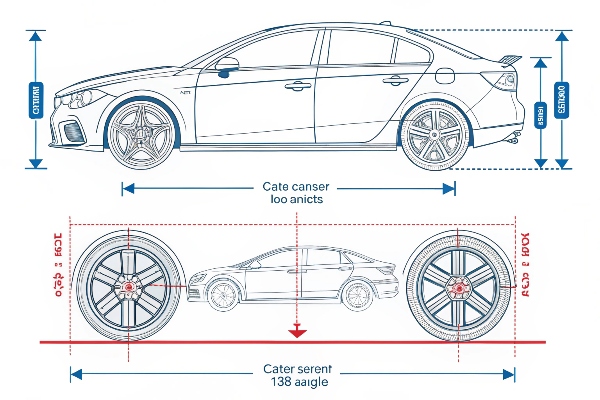
The relationship between wheels and alignment is more complex than most realize. Through my work with performance vehicles, I've learned that even seemingly minor wheel changes can require alignment adjustments. This is especially true when changing not just diameter but also width and offset.
Wheel offset affects what engineers call the "scrub radius"—the distance between the steering axis and the center of the tire contact patch. Changes to this geometry can alter steering feel, feedback, and stability. Negative offset wheels (where more of the wheel sits outward from the mounting face) increase the scrub radius, potentially causing additional steering effort and different feedback through the steering wheel.
Width changes also impact alignment. Wider wheels effectively push the contact patch outward, altering camber angles (the vertical tilt of the wheel). Without adjustment, this can lead to uneven tire wear, typically on the inner or outer edges. I always recommend a professional alignment after significant wheel changes, especially on performance-oriented vehicles where handling is critical.
Low-profile tires that accompany larger wheels provide less cushioning and are less forgiving of alignment issues. Minor misalignments that might go unnoticed with taller sidewalls become immediately apparent with low-profile tires, manifesting as uneven wear or pulling during braking.
Alignment Considerations After Wheel Changes:
| Alignment Parameter | Effect of Wheel Changes | Symptoms of Misalignment |
|---|---|---|
| Camber | Changed by offset/width differences | Outside or inside edge tire wear |
| Toe | May need adjustment with new geometry | Feathered tire wear, pulling |
| Caster | Less affected but influences stability | Steering return issues, wandering |
| Scrub radius | Changed by offset differences | Altered steering feel, torque steer |
Conclusion
Upgrading from 17-inch to 18-inch wheels is definitely possible when you maintain the correct overall diameter, ensure proper fitment, and consider potential impacts on ride quality and alignment. Always consult with professionals if you're uncertain about compatibility.
